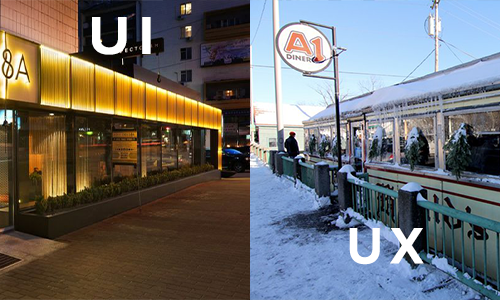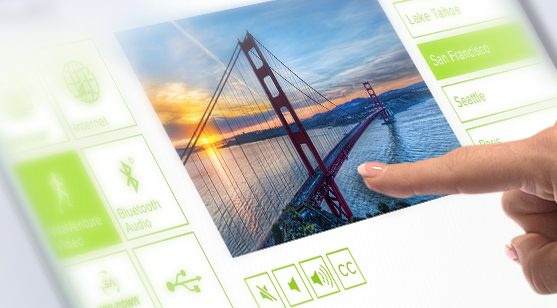Whether you’ve heard the terms UX (User Experience) or UI (User Interface) or not, I can assure you that you’re all too familiar with both. UI, or User Interface, is what you see when you look at a piece of technology. It can be the way the layout and colors appear on an iPhone, or how the channel guide looks on your cable TV box. It’s the interface that you use to interact with any and every bit of tech that pops up in daily life. Love the way your bank’s website looks? UI. You have a preference for the way Candy Crush uses specific shapes and colors over similar match 3 games... Yep. UI. The user interface touches a nerve with our creative minds and draws us in with clean design, attractive colors, and how things generally appear to the user.
 But, what is it like to interact with that interface? Once you get past the glitz and glamour of the home page or the attractive look of the layout, how easy is it to find what you need or extract functional and productive use? That’s UX, or User Experience. If you’ve ever purchased a business app because it looked great in the app store and seemed to have functions that would enhance your productivity only to find out that it’s hard to understand and difficult to use with zero intuitive operation, then you, my friend, have been foiled by a bad UX.
But, what is it like to interact with that interface? Once you get past the glitz and glamour of the home page or the attractive look of the layout, how easy is it to find what you need or extract functional and productive use? That’s UX, or User Experience. If you’ve ever purchased a business app because it looked great in the app store and seemed to have functions that would enhance your productivity only to find out that it’s hard to understand and difficult to use with zero intuitive operation, then you, my friend, have been foiled by a bad UX.
Both UI and UX serve a very important function and the objective of a product development team is to marry both into a flawless relationship of user fulfillment. But, let’s explore why one makes a better foundation for development. Here’s a very simple analogy:
Let’s suppose you decide to try what appears to be a newly opened upscale restaurant. The exterior is beautiful with an exotic sounding name and contemporary design. As you walk in, everything you see spells “luxury”. A maître di is there to take your coat and show you to your candlelit table complete with glistening silverware and more forks than you could ever possibly use. So far, everything has led you to believe that what you're about to experience will be fantastic. That’s a good UI.
However, let's say that once you sit down you realize that the waiter never seems to be around and is extremely rude when he is. The food you ordered took forever to arrive and is both cold and bland, and that $100 bottle of Champagne you bought is warm and flat. Well, then you’ve just had a bad user experie
nce. Great looking restaurant (UI), but the food and service were bad (UX). One doesn’t necessarily guarantee the other.
Now, let’s use our restaurant analogy another way. Have you ever channel surfed and landed on the Food Network? It’s one of those roadside restaurant shows where the host travels all over the country to find America’s best food you’ve never heard of. Often times, these places are a little old, a little run down, and may not have a well-dressed wait staff. By initial accounts, they have a UI that’s not as good as our earlier 4-star example. But once you walk in, the owner greets you with a smile and asks if you’ve ever been in before and then proudly retells the story of how his grandfather toiled over the secret recipe that’s made the locals keep coming back for years. The people in line are eager to give you their
picks for best item on the menu, and when you first bite into their savory sensation, a cry of delectable joy escapes your lips. Well, you have just been handed a great User Experience.
 Now, of these two analogies, which business do you think will last longer? Typically, a dynamic User Experience will trump a glamorous User Interface. But as I said before, the best products in the world should marry the two together. A great product developer will first think about how a person will use something and design it so that the primary function of the device is easy and intuitive. Once a product has achieved the ability of clearly conveying its primary function to the user and pulls them into a memorable and intuitive experience, then the User Interface can be laid on top to complete a grand product.
Now, of these two analogies, which business do you think will last longer? Typically, a dynamic User Experience will trump a glamorous User Interface. But as I said before, the best products in the world should marry the two together. A great product developer will first think about how a person will use something and design it so that the primary function of the device is easy and intuitive. Once a product has achieved the ability of clearly conveying its primary function to the user and pulls them into a memorable and intuitive experience, then the User Interface can be laid on top to complete a grand product.
As a fitness equipment manufacturer, our job is to deliver something that is developed from a Fitness First philosophy and deliver a great User Experience as it relates to an exercise machine. Sure, we could put gaming apps and various other non-fitness technologies on a treadmill console, but that would stray from the fundamental principal of the product’s intent. When I want to play a mobile game, I’ll use my phone or tablet. When I wantto train for a 5K, I’ll use a treadmill. Just like our examples above illustrate, people ultimately go to a restaurant to have a great meal. So whether it’s food, fitness, or any other product, make sure you get the recipe right first, and then master the presentation. Do that, and you’ll have customers for life.
